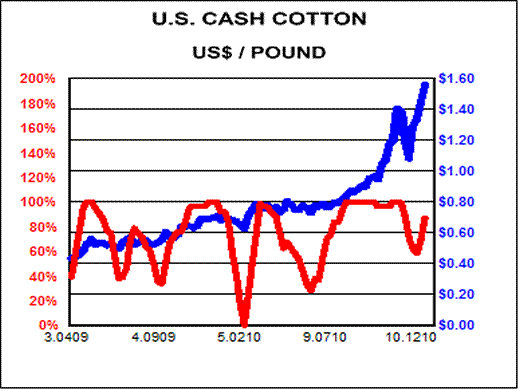Agri-Food's Impact on Christmas and 2011 Clothing Prices as Cotton Price Continues to Soar
Commodities / Agricultural Commodities Dec 23, 2010 - 12:13 PM GMTBy: Ned_W_Schmidt
 Hopefully, those of you celebrating Christmas included lots of clothing in your gift shopping. Reason for that is giving or buying clothing is likely to become considerably more expensive in 2011. Our first chart below portrays the rather dramatic move in U.S. cotton prices over the past 90 weeks. Most noticeable is the price burst since late Summer, when the world discovered that global demand for cotton exceeded the global supply of cotton.
Hopefully, those of you celebrating Christmas included lots of clothing in your gift shopping. Reason for that is giving or buying clothing is likely to become considerably more expensive in 2011. Our first chart below portrays the rather dramatic move in U.S. cotton prices over the past 90 weeks. Most noticeable is the price burst since late Summer, when the world discovered that global demand for cotton exceeded the global supply of cotton.

Those higher prices of the latter half of 2010 will be incorporated into the cost of clothing in 2011. World is being forced to pay more for cotton to entice farmers to grow cotton rather than food. Farmers can only grow one Agri-Food crop at a time in those fields, generally one time a year. Farm fields are not factories. If you want cotton, be prepared to give up some cornflakes. It is either cotton or “corn.” And forget all that nonsense about ethanol raising the price of Agri-Food to the world. Every time someone buys a T-shirt, the price of Agri-Food will rise.
Oh, and forget shifting to wool. According to the USDA, price of wool is up about 50% from a year ago. That is going to make those sweaters needed to survive Global Cooling a lot more expensive. But, that has other ramifications. If the world wants wool, it will need to allow lambs to become wool bearing adults. So, enjoy that rack of lamb this holiday, you may not be able to afford it next year cause you bought a sweater.
As the next chart portrays, cotton was the winner this past year. A bale of cotton outperformed Gold by a factor of about 4 and the stock market by a factor of more than 5. In fact, 9 of 15 Agri-Food commodities in that chart performed better than Gold. That development should come as no surprise. Every person around the world must buy Agri-Foods. No one by necessity needs Gold.

Extraordinary gains achieved by Agri-Food commodities in 2010 are not likely to be repeated in the coming year. Tractor stocks will not likely rise by 60-100% again in 2011, as they did this past year. However, with the global Agri-Food system moving to a short supply situation in the long-term, price gains will need to be above those experienced by other prices. Not only will they need to be, but because Agri-Food commodities in general are operating in the price inelastic portion of the long-run supply curve they will. $7 corn this time next year is a real possibility, and much of the world will be glad to get it at that price.
Performance of Tier One Agri-Equities was also good in 2010, almost double that of the S&P 500. Tier Two, Agri-China equities, lagged during this period. In 2011 those positions will likely be reversed. Those Agri-Equities with exposure to the massive task of feeding more than 1.4 billion people have a long term wind to their back. That subtly aside, a portfolio without Agri-Equities will be at a serious disadvantage in the decade ahead.
By Ned W Schmidt CFA, CEBS
AGRI-FOOD THOUGHTS is from Ned W. Schmidt,CFA,CEBS, publisher of The Agri-Food Value View, a monthly exploration of the Agri-Food grand cycle being created by China, India, and Eco-energy. To contract Ned or to learn more, use this link: www.agrifoodvalueview.com.
Copyright © 2010 Ned W. Schmidt - All Rights Reserved
Ned W Schmidt Archive |
© 2005-2022 http://www.MarketOracle.co.uk - The Market Oracle is a FREE Daily Financial Markets Analysis & Forecasting online publication.



